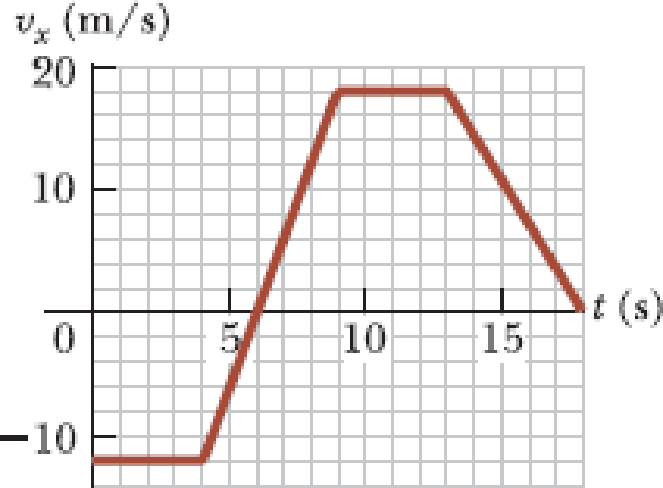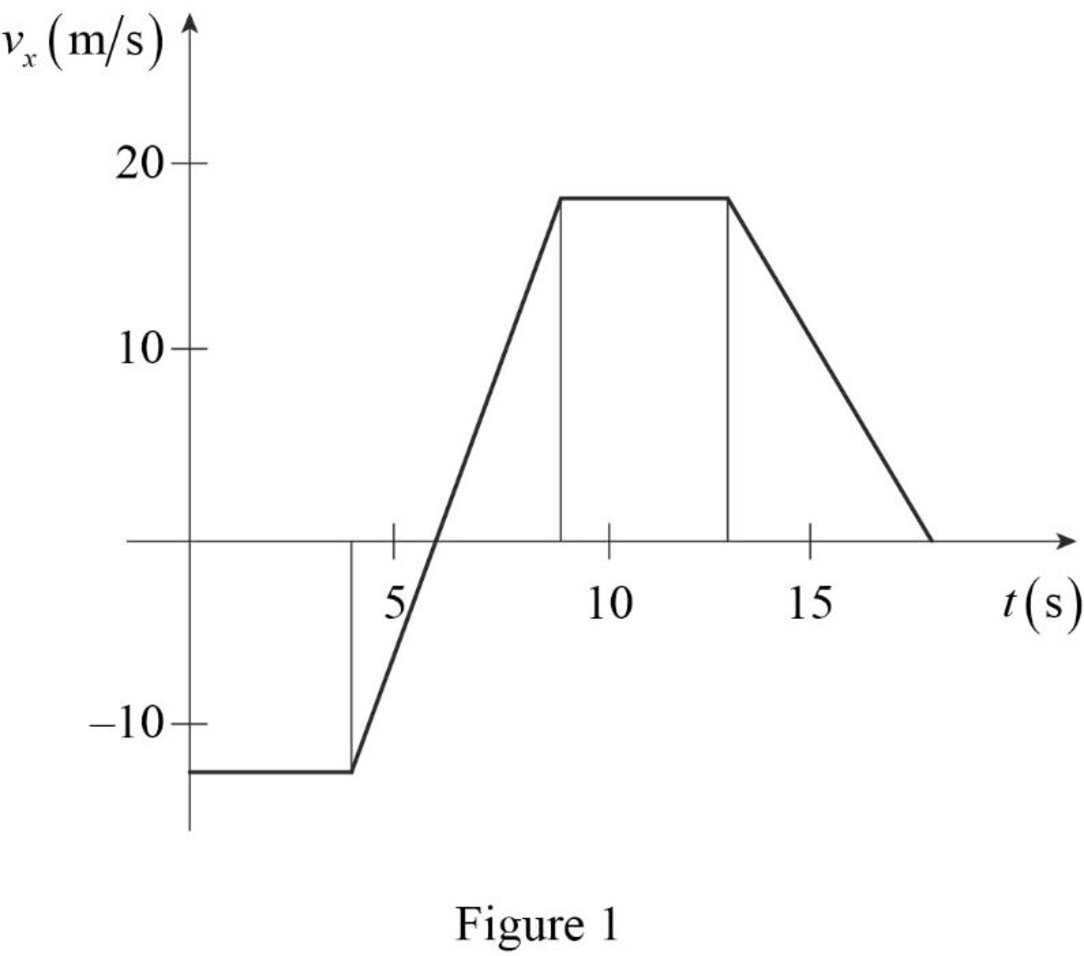
Concept explainers
An object is at x = 0 at t = 0 and moves along the x axis according to the velocity–time graph in Figure P2.40. (a) What is the object’s acceleration between 0 and 4.0 s? (b) What is the object’s acceleration between 4.0 s and 9.0 s? (c) What is the object’s acceleration between 13.0 s and 18.0 s? (d) At what time(s) is the object moving with the lowest speed? (e) At what time is the object farthest from x = 0? (f) What is the final position x of the object at t = 18.0 s? (g) Through what total distance has the object moved between t = 0 and t = 18.0 s?
Figure P2.40

(a)
The object’s acceleration between
Answer to Problem 40P
The object’s acceleration between
Explanation of Solution
Acceleration is a measure of how rapidly the velocity is changing. It is defined as the change in velocity per unit time. The slope of the velocity versus time graph in a particular time interval gives the acceleration during that interval.
In the given velocity versus time graph, the curve is a straight parallel to the time axis between
Conclusion:
Therefore, the object’s acceleration between
(b)
The object’s acceleration between
Answer to Problem 40P
The object’s acceleration between
Explanation of Solution
The slope of the graph in the given interval gives the acceleration of the object during it.
Write the equation for the acceleration of the object between
Here,
Conclusion:
From the graph, the value of
Substitute
Therefore, the object’s acceleration between
(c)
The object’s acceleration between
Answer to Problem 40P
The object’s acceleration between
Explanation of Solution
Write the equation for the acceleration of the object between
Here,
Conclusion:
From the graph, the value of
Substitute
Therefore, the object’s acceleration between
(d)
The times at which the object moves with the lowest speed.
Answer to Problem 40P
The times at which the object moves with the lowest speed are
Explanation of Solution
In a velocity versus time graph, the velocity of an object will be plotted as a function of time. The velocity at a particular instant of time can be directly observed from the graph. Speed is the magnitude of velocity.
Speed can never be negative. The lowest possible value of speed is zero. In the graph, the velocity of the object is zero at
Conclusion:
Therefore, the times at which the object moves with the lowest speed are
(e)
The time at which the object is farthest from
Answer to Problem 40P
The time at which the object is farthest from
Explanation of Solution
The given velocity versus time graph is of an object starting from
From
Conclusion:
Therefore, the time at which the object is farthest from
(f)
The final position of the object at
Answer to Problem 40P
The final position of the object at
Explanation of Solution
The cumulative area under the graph gives the maximum distance attained by the object.
The velocity versus time graph is shown below.

Write the equation for the area of a rectangle.
Here,
Write the equation for the area of a triangle.
Here,
The area from
In figure 1, the length of the rectangle from
Substitute
Here,
The area from
In figure 1, the base of the triangle from
Substitute
Here,
The area from
In figure 1, the base of the triangle from
Substitute
Here,
The area from
In figure 1, the length of the rectangle from
Substitute
Here,
The area from
In figure 1, the base of the triangle from
Substitute
Here,
Write the equation for the farthest distance.
Here,
Conclusion:
Substitute
Therefore, the final position of the object at
(g)
The total distance the object has moved between
Answer to Problem 40P
The total distance the object has moved between
Explanation of Solution
The total distance travelled can be calculated by counting all contributions computed in part (f) as positive.
Conclusion:
Substitute
Here,
Therefore, the total distance the object has moved between
Want to see more full solutions like this?
Chapter 2 Solutions
Bundle: Principles of Physics: A Calculus-Based Text, 5th + WebAssign Printed Access Card for Serway/Jewett's Principles of Physics: A Calculus-Based Text, 5th Edition, Multi-Term
- A rectangular current loop (a = 15.0 cm, b = 34.0 cm) is located a distance d = 10.0 cm near a long, straight wire that carries a current (Iw) of 17.0 A (see the drawing). The current in the loop is IL = 21.0 A. Determine the magnitude of the net magnetic force that acts on the loop. Solve in N. a b IL Iwarrow_forwardTwo long, straight wires are separated by distance, d = 22.0 cm. The wires carry currents of I1 = 7.50 A and I2 = 5.50 A in opposite directions, as shown in the figure. Find the magnitude of the net magnetic field at point (B). Let r₁ = 12.0 cm, r2 = 7.00 cm, and r3 = 13.0 cm. Solve in T. 12 d A √3arrow_forwardI tried to solve this question, and I had an "expert" answer it and they got it wrong. I cannot answer this questionarrow_forward
- Eddie Hall is the current world record holder in the deadlift, a powerlifting maneuver in which a weighted barbell is lifted from the ground to waist height, then dropped. The figure below shows a side view of the initial and final positions of the deadlift. a 0 = 55.0° Fift h22.5 cm i hy = 88.0 cm b iarrow_forwardsolve for (_) Narrow_forwardTwo boxes of fruit on a frictionless horizontal surface are connected by a light string as in the figure below, where m₁ = 11 kg and m₂ = 25 kg. A force of F = 80 N is applied to the 25-kg box. mq m1 Applies T Peaches i (a) Determine the acceleration of each box and the tension in the string. acceleration of m₁ acceleration of m₂ tension in the string m/s² m/s² N (b) Repeat the problem for the case where the coefficient of kinetic friction between each box and the surface is 0.10. acceleration of m₁ acceleration of m₂ tension in the string m/s² m/s2 Narrow_forward
- All correct but t1 and t2 from part Aarrow_forwardThree long, straight wires are mounted on the vertices of an equilateral triangle as shown in the figure. The wires carry currents of I₁ = 3.50 A, I2 = 5.50 A, and I3 = 8.50 A. Each side of the triangle has a length of 34.0 cm, and the point (A) is located half way between (11) and (12) along one of the sides. Find the magnitude of the magnetic field at point (A). Solve in Teslas (T). I₁arrow_forwardNumber There are four charges, each with a magnitude of 2.38 μC. Two are positive and two are negative. The charges are fixed to the corners of a 0.132-m square, one to a corner, in such a way that the net force on any charge is directed toward the center of the square. Find the magnitude of the net electrostatic force experienced by any charge. ips que Mi Units estic re harrow_forward
- Two long, straight wires are separated by distance, d = 22.0 cm. The wires carry currents of I1 = 7.50 A and I2 = 5.50 A in opposite directions, as shown in the figure. Find the magnitude of the net magnetic field at point (B). Let r₁ = 12.0 cm, r2 = 7.00 cm, and r3 = 13.0 cm. Solve in T. 12 d A √3arrow_forwardThank you in advance, image with question is attached below.arrow_forwardQuestion is attached, thank you.arrow_forward
 Principles of Physics: A Calculus-Based TextPhysicsISBN:9781133104261Author:Raymond A. Serway, John W. JewettPublisher:Cengage Learning
Principles of Physics: A Calculus-Based TextPhysicsISBN:9781133104261Author:Raymond A. Serway, John W. JewettPublisher:Cengage Learning Glencoe Physics: Principles and Problems, Student...PhysicsISBN:9780078807213Author:Paul W. ZitzewitzPublisher:Glencoe/McGraw-Hill
Glencoe Physics: Principles and Problems, Student...PhysicsISBN:9780078807213Author:Paul W. ZitzewitzPublisher:Glencoe/McGraw-Hill University Physics Volume 1PhysicsISBN:9781938168277Author:William Moebs, Samuel J. Ling, Jeff SannyPublisher:OpenStax - Rice University
University Physics Volume 1PhysicsISBN:9781938168277Author:William Moebs, Samuel J. Ling, Jeff SannyPublisher:OpenStax - Rice University Physics for Scientists and Engineers: Foundations...PhysicsISBN:9781133939146Author:Katz, Debora M.Publisher:Cengage Learning
Physics for Scientists and Engineers: Foundations...PhysicsISBN:9781133939146Author:Katz, Debora M.Publisher:Cengage Learning An Introduction to Physical SciencePhysicsISBN:9781305079137Author:James Shipman, Jerry D. Wilson, Charles A. Higgins, Omar TorresPublisher:Cengage Learning
An Introduction to Physical SciencePhysicsISBN:9781305079137Author:James Shipman, Jerry D. Wilson, Charles A. Higgins, Omar TorresPublisher:Cengage Learning College PhysicsPhysicsISBN:9781305952300Author:Raymond A. Serway, Chris VuillePublisher:Cengage Learning
College PhysicsPhysicsISBN:9781305952300Author:Raymond A. Serway, Chris VuillePublisher:Cengage Learning





